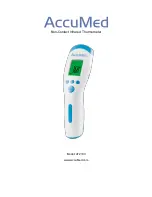
ORAL METHOD
1. Do not drink hot or cold fluids, exercise, smoke, or perform
other activities that will raise or lower temperature readings
when compared to your normal, average temperature. The
mouth should remain closed up to 5 minutes before attempting
a reading.
2. Place the sensor tip well under the tongue as indicated by the
"
√
". (see figure 2).
3. The peak temperature should be reached in approximately
60 seconds. Opening the mouth or improper placement of the
probe tip could result in a longer time for a reading.
4. When the peak temperature is reached, the "°C" symbol will
stop flashing, and the thermometer will beep repeatedly.
Please note:
It is not necessary to hear the beep to ensure the peak temperature has been reached. When
the "°C" symbol stops flashing and the display reads a consistent temperature, the peak
temperature has been reached.
5. Read and record the temperature and time for reference. The reading will automatically be
stored in the memory.
6. Push the multi-function button to turn the unit off. If you do not turn the unit off, it will shut off
automatically in approximately 9 minutes.
RECTAL METHOD
Lubricate the tip of the thermometer with a water-soluble personal lubricant or petroleum jelly. Lie
on your side with knees slightly bent. With one hand, gently slide the tip of the thermometer no
more than 1.3 cm (0.5") into the rectum. Note: Now see steps 4, 5 and 6 above. Once used rectally,
the thermometer should not be used orally for sanitary reasons.
VAGINAL METHOD
Please seek guidance from your health care professional.
V. RECORDING BASAL TEMPERATURE
Please refer to the sample recording and blank temperature tracking charts enclosed. Prepare
your chart following the example. Day 1 for each cycle is the first day of menstruation (your
"Period"). Above the pre-printed days of the cycle enter corresponding calendar dates. During your
menstrual flow, it is not necessary to record temperatures (unless you have short cycles). Instead,
mark an X in each space provided to indicate the number of days your period lasts. Begin recording
your basal temperature the first morning following the end of menstruation.
For each daily temperature, trace down the column below the cycle day until it intersects with
your recorded temperature. Place a dot at the intersection. A notation should be made for any
rise in temperature due to illness, emotional stress, or sleeplessness. Refer to the example of a
completed chart on page 10. Intercourse can be indicated by placing a circle around the dot of
the appropriate day. Chart your readings for at least three months in order to be sure that you
have determined your approximate time of ovulation during any regular menstrual cycle. Careful
temperature recording will help establish your individual pattern. Completed charts should then
be presented to your physician or family planning counselor, who will assist you in accurately
interpreting your results.
3
Figure 2
Summary of Contents for RX555
Page 14: ...8 ...
Page 15: ...9 Extra Large version for photocopy purposes ...

































